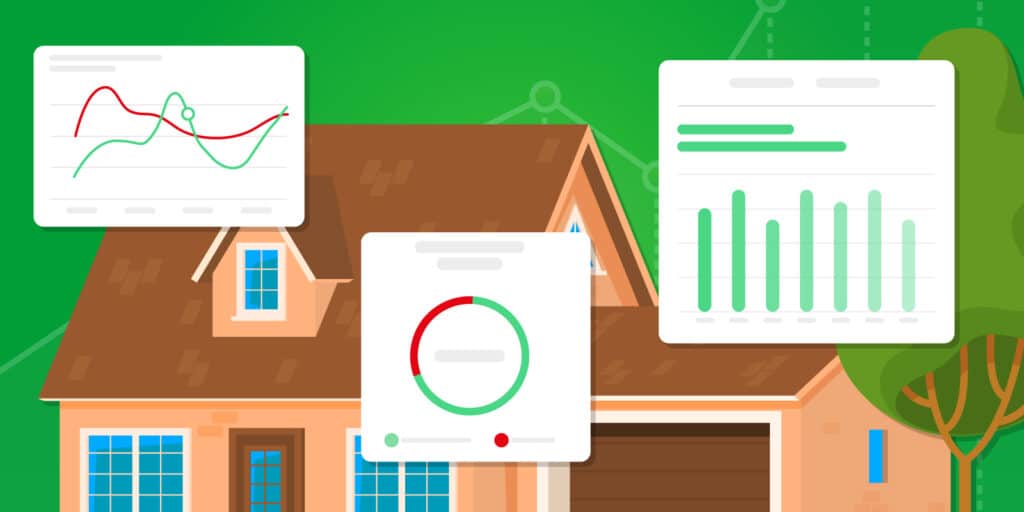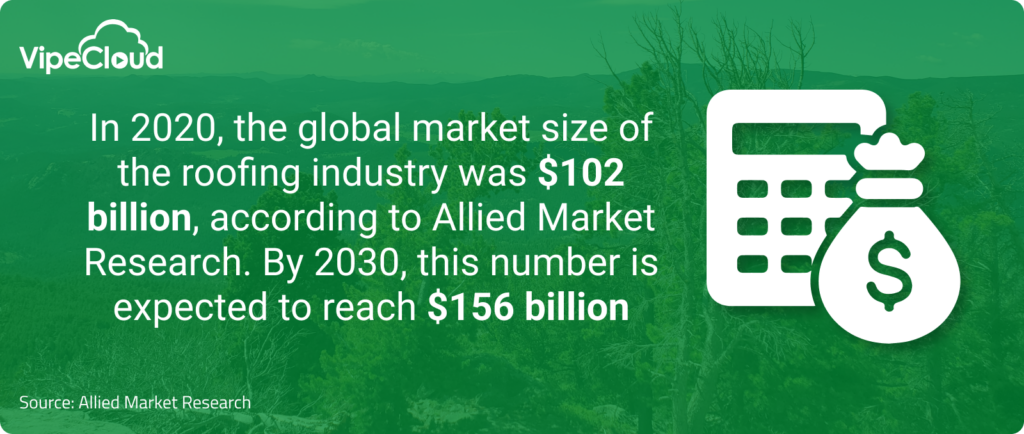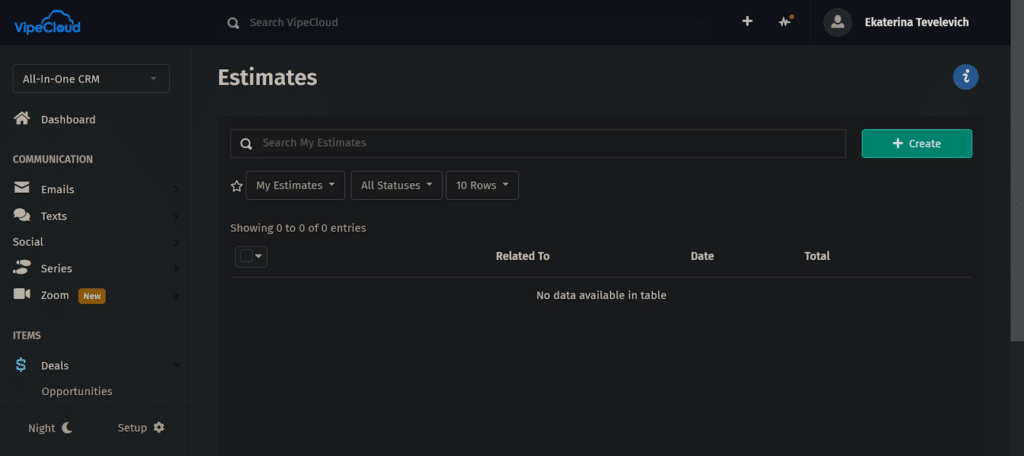Last updated on August 7th, 2023

Curious about the current and future state of the roofing industry? Read this guide for statistics that’ll keep you up-to-date and informed for your roofing business.
Today we’ve compiled 31 facts that roofing company owners and professionals need to know.
Knowing these stats can help you make better long-term decisions with your roofing company and catch trends faster.
Let’s begin.
Table of Contents:
- How To Use These Roofing Statistics
- The History Of The Roofing Industry
- Roofing Industry Outlook
- Trends In The Roofing Industry
- Understand The Roofing Market Size
- Profit Margins In The Roofing Industry
- Roofing Accidents By the Numbers
- Roofing Statistics: The Case For CRM Usage
- The Future Of The Roofing Industry
- The #1 CRM For Roofers

VipeCloud is the only Automation tool your small business needs to
be the hero to your customers.
With Email, Texting, Social, Suites, Chat, Stories, Video Email & Sign Up Forms fully built-in, we provide you with the perfect platform to grow your business.
15 Day Free Trial – Get started risk free. No CC needed.
How To Use These Roofing Statistics
These statistics give you a realistic snapshot of the state of the roofing industry.
You can use these facts to make more accurate conclusions on the different areas of your roofing business.
Your conclusions can range from the best services to offer and how to keep workers safe to the best software to use and the trends to look for.
Another plus from these roofing statistics is a better understanding of your customers.
You’ll gain insights into customer demand which can help you improve your service to align with their wants and needs.
Lastly, use these numbers to future-proof your company.
The trends mentioned here will help you avoid negative trends and catch positive ones as they come along.
The History Of The Roofing Industry
Shelter has been a big part of survival and human civilization.
Early humans had to do more than reside in caves. They had to find a way to construct shelter and protection from natural forces.
Archeologists say that early humans built temporary shelters for hunting and gathering. Later, they made permanent places to live during the agricultural era.
The earliest known roofing materials were thatch, leaves, and straw.
But the earliest material to be used that’s still used today is the clay tile (potentially dating back as far as 10,000 BC)
New materials and roofing techniques were developed and discovered by the Middle Ages and beyond. The newer materials included wood shingles, slate, and metal.
By the 20th century, the roofing industry began to snowball, especially with the emergence of asphalt shingles, fiberglass, and other synthetic materials (These gave way to more durable and efficient roofs.)
Today, the roofing industry is a multi-billion dollar industry, with various materials, styles, installation methods, and technology homeowners can choose from.
Let’s look further into the current state of the roofing industry based on statistics.
Roofing Industry Outlook
One of the more popular roofing services is roofing repair.
The average roof repair in the United States costs $985, and most homeowners spend between $376 and $1,649 on repairs.
When it comes to roofing replacements, rates can vary, especially based on seasonal demand.
Fall is the peak season for roofing replacements throughout the industry. (The average residential roof in the United States is 1,600 square feet.)
As a roofing company, fall is a critical chance to offer special deals in your local area to catch the wave of roof replacement customers.
But remember to plan — after all, the number of roofing contractors and competitors is rising steadily.
According to IBISWorld, 81,175 Roofing Contractor businesses were in the U.S. in 2022, increasing by 1.5% from 2021.
Fortunately, the roofing industry has a growing market, which is good for all contractors.

In 2020, the global market size of the roofing industry was $102 billion, according to Allied Market Research. By 2030, this number is expected to reach $156 billion.
From a market segment standpoint, commercial roofing makes up most of the market at 57.0%. (Commercial roofing projects usually require bigger budgets since the work requires more labor, materials, and equipment.)
Trends In The Roofing Industry
In North America, roof replacements are the most in-demand service at over 90% of the market.
This is in both volume and value.
In other words, lots of people are getting replacements and spending more to do so. As demand grows, so does revenue for many contractors.
Most customers spend between $5,500 and $11,00 for a replacement. There’s potential for more demand in areas more prone to inclement weather, like hail storms. (Storms create roofing service demand quickly!)
Hail storms will continue to be one of the number one causes of roofing emergencies in 2023 according to Roofer’s Guild.
Texas leads the entire U.S. with the most hail storms in 2022, followed by Nebraska and Minnesota.
Another trend in the roofing industry is revenue growth.
One survey found that more than 65% of respondents said they reported sales and revenue growth. And about half of them expected continued growth.
Understand The Roofing Market Size
As of 2023, the market size of the roofing industry is $56.7 billion.
This makes roofing rank 16th in construction industry market size.
Growing industries are indicators of opportunity. Newer contractors considering expanding their roofing business can be confident in the growing demand for their service.
Profit Margins In The Roofing Industry
Although the roofing industry is growing as demand does, profit margins are seeing a dip.
About 80% of roofing business owners have seen a 10% increase in labor costs in the last few years (whether this be hiring costs, materials, software, and more.)
Roofing companies typically make between 20% and 40% gross profit. This sits below the recommended healthy gross profit margin of 40% – 50% recommended by BDC.
Roofing Accidents By the Numbers
In 2017, there were 4 types of roofing accidents that accounted for 59.9% of what victims experienced. Here are the 4 highest causes of roofing accidents:
- Falls
- Being struck by an object
- Electrocutions
- Caught in-between something
Falls are responsible for 3/4ths of total roof injuries.
This shows the importance of safety equipment like sturdy extension ladders and fall protection kits.
Unfortunately, injuries are nothing new in the construction industry as a whole.
The construction industry already has the highest number of fatal workplace injuries nationwide in one year, with a fatality rate of 3.2 per 100,000 workers.
And according to the Bureau of Labor Statistics, the roofing sector (of construction) had a death rate 1.3X higher than other construction sectors. At 29.9 deaths per 100,000 full-time equivalent workers, roofers experience fatalities at almost 2X the rate for all construction workers (15.2).
Roofing Statistics: The Case For CRM Usage
The roofing industry is adopting more technology to make work more efficient.
Estimating software, for instance, is already used by 57% of roofing professionals to deliver pricing quotes to customers faster.
Fortunately, estimates can combine with your marketing and customer communication tools – a combo you can find in some CRM software.


CRM (customer relationship management) is software roofing companies use to keep up with clientele year-round.
About 91% of businesses with more than 11 employees now use CRM.
Roofing companies can use text and email to deliver personalized customer experiences. This is an essential thing customers look for, according to a McKinsey and Company report.
They found that 71% of consumers expect companies to deliver personalized interactions. This means communications that help a specific customer solve their specific problems faster.
Understanding the needs and desires of a customer starts with holding accurate information about them.
This is what makes CRM an invaluable asset for roofing contractors.
You can keep a record of customer information and data all in one place – from their ideal roofing materials to their best availability for phone communication.
SMS using CRM is one of the best ways to reach roofing customers. Here are some eye-opening statistics from g2:
- 83% of consumers like to get appointment reminders via text, but only 20% of businesses do so.
- 43% of consumers mentioned they’ve proactively texted a business.
- 54% of consumers would like to receive promotions via SMS, but only 11% of businesses send them.
You can meet the text communication demand of your customers straight from your CRM.

Stay on top of conversations whether you’re sending manual texts or automated campaigns.
Tracking the customer journey is another perk of a roofing CRM.
The Future Of The Roofing Industry
The future of the roofing industry is bright.
Employment is expected to grow 5% over the next decade.
The U.S. roofing market is forecasted to grow at a 6.8% CAGR (compound annual growth rate) between 2023 and 2028.
Metal roofing, specifically, is expected to grow at a CAGR of 4.3% between 2021 and 2026.
With metal roofs already a popular choice in commercial roofing, this growth will help boost the expansion of the commercial roofing market.
Take Advantage Of The Latest Trends With A CRM For Roofers
As the roofing industry grows and more competitors enter the market, you’ll need a CRM to keep up with customers, market more effectively, and help your company stand out.
Luckily finding a great CRM for roofing isn’t difficult, especially with VipeCloud.
VipeCloud is an easy-to-use CRM built for small and medium-sized businesses. Its top-tier customer support makes it a go-to solution in the services industry.
Want to see how it works?
You can request a demo today.
And If you’d like to try VipeCloud for your roofing company, you can claim your free 15-day trial.

Leave a Reply